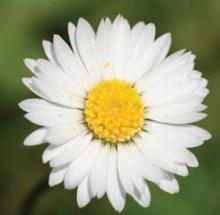Known also as the common daisy or English daisy, Bellis perennis is a perennial plant belonging to the Asteraceae or Compositae (aster, daisy, or sunflower) family. Native to Europe and North Africa, it has been used in traditional medicine in Europe since the Middle Ages to treat bruises, broken bones, muscle pain, cutaneous wounds, and rheumatism. Other skin applications include eczema, boils, inflammation, and purulent skin disease. In addition, B. perennis has been used in folk medicine to treat upper respiratory tract infections, gastritis, stomachache, diarrhea, bleeding, rheumatism, common colds, and headache (Pharm. Biol. 2014 March 12 [Epub ahead of print]; Pharm. Biol. 2012;50:1031-7; Chem. Pharm. Bull. [Tokyo] 2008;56:559-68; Chem. Pharm. Bull. [Tokyo] 2011;59:889-95; Lim, T.K. Edible Medicinal and Non-Medicinal Plants. Springer: Dordrecht, 2014, pp. 204-11).
Chemistry
B. perennis roots and flowers have been shown to contain several important bioactive constituents, including triterpene saponins, anthocyanins, flavonoids, polysaccharides, and polyacetylenes (Chem. Pharm. Bull. [Tokyo] 2008;56:559-68; SOFW J. 2005;131:40-9). In 2008, Morikawa et al. identified newly isolated triterpene saponins in B. perennis. These compounds, labeled as perennisosides I-VII, exhibited inhibitory activity on serum triglyceride elevation in olive oil–treated mice (J. Nat. Prod. 2008;71:828-35). That same year, Yoshikawa et al. isolated six new acylated oleanane-type triterpene oligoglycosides (perennisaponins A-F) from the flowers of B. perennis in addition to 14 saponins, 9 flavonoids, and 2 glycosides (Chem. Pharm. Bull. [Tokyo] 2008;56:559-68).
In 2011, Morikawa et al. isolated five new triterpene saponins (perennisosides VIII-XII) from the methanolic extract of B. perennis flowers. The extract was shown to suppress gastric emptying in olive oil–laded mice (Chem. Pharm. Bull. [Tokyo] 2011;59:889-95).
Early in 2014, Pehlivan et al. used bioassay-guided fractionation and isolation procedures to isolate an oleanane-type saponin from B. perennis that exhibited antitumor activity, the first such finding associated with B. perennis flowers. Tumor inhibition of 99% was achieved by the most active fraction at 3,000 mg/L (Pharm. Biol. 2014 March 12 [Epub ahead of print]).
Wound-healing capacity
In 2012, Karakas et al. studied the wound-healing activity displayed by the dried flowers of B. perennis in 12 male adult Wistar albino rats over a 30-day period. Six wounds were introduced onto each animal, with two treated topically once a day with a hydrophilic ointment containing an n-butanol fraction of B. perennis, two treated daily with the ointment minus the B. perennis fraction, and two untreated wounds used as control. Statistically significant differences were noted with 100% wound closure in the B. perennis group, 87% in the control group, and 85% in the other treatment group. The investigators concluded that their findings represented the first scientific confirmation supporting the traditional usage of B. perennis for wound healing. They noted that the topical administration of an ointment formulated with an n-butanol fraction of B. perennis flowers exhibits wound healing activity without inducing scars in a circular excision wound model in rats (Pharm. Biol. 2012;50:1031-7).
Antimicrobial activity against gram-positive and gram-negative bacteria, as well as anticancer activity against human leukemia cells in vitro, has also been associated with B. perennis (Lim, T.K. Edible Medicinal and Non-Medicinal Plants. Springer: Dordrecht, 2014, pp. 204-11).
Skin-lightening activity
Extracts of B. perennis are included in the product Belides that has been combined in a formulation with emblica and licorice for use as a skin-lightening agent. In 2010, Costa et al. conducted a monoblind clinical study to assess the clinical efficacy of the combination of Belides, emblica, and licorice 7%, compared with hydroquinone 2% for the treatment of epidermal or mixed melasma in 56 women aged 18-60 years. Subjects (ranging from Fitzpatrick skin type I to IV) exclusively used an SPF 35 sunscreen for 60 days before being selected for either the herbal combination cream treatment, applied twice daily, or the hydroquinone group, applied nightly.
Depigmentation was observed in 78.3% of the herbal combination group and 88.9% of the hydroquinone group, among the 23 volunteers in the herbal group and 27 in the hydroquinone group who completed the study. No statistically significant differences were found between the treatment regimens in ameliorating melasma, but fewer adverse cutaneous reactions were associated with the herbal treatment. The investigators found the combination of Belides, emblica, and licorice to be a safe and effective option for treating melasma (An. Bras. Dermatol. 2010;85:613-20). Previously, Belides was shown to be nearly twice as active as arbutin and an effective skin-lightening agent in a pilot study with human volunteers (SOFW J. 2005;131:40-9; Lim, T.K. Edible Medicinal and Non-Medicinal Plants. Springer: Dordrecht, 2014, pp. 204-11).


